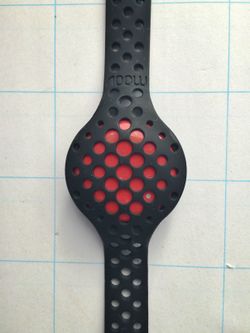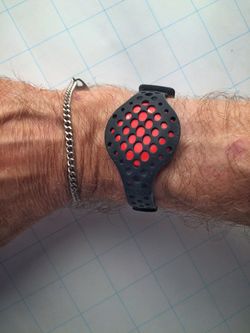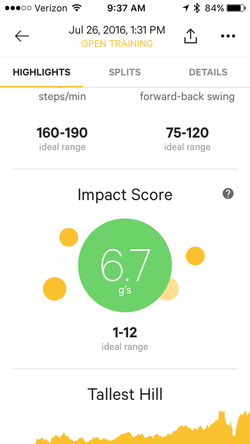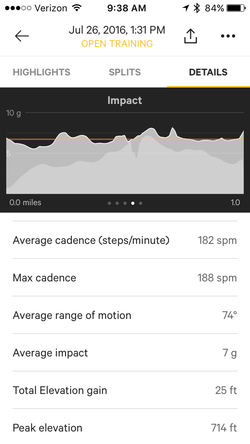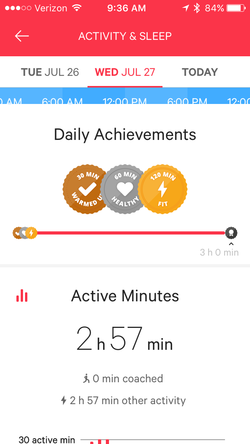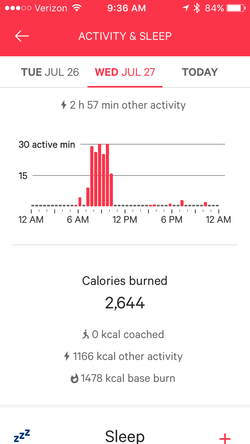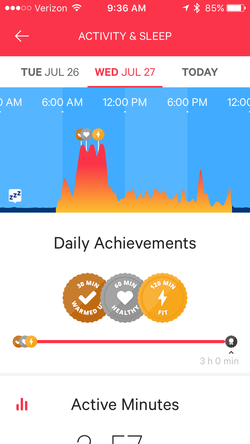Moov Now Review
Moov Now is a tiny movement sensor that is primarily designed as an activity tracker. However, this review will focus on its capabilities as a | Running Sensor, though will also cover some of its other functionality. For runners Moov Now is capable of measuring Cadence, Range Of Motion and Tibial Impact. Cadence is probably the most critical of all metrics to capture for runners, and thankfully it's a fairly easy to measure and so it's become quite pervasive. While the Range Of Motion is slightly intriguing, it's unclear to me how to interpret the value. The most interesting aspect of Moov Now is its ability to measure Tibial Impact.
- Note: currently Moov Now display an incorrect value for the average impact score for a run. The real time display during the run appears close (based on validation with TgForce), but the average is vastly higher. I have an open bug report with Moov.
Moov Now is Error: Could not parse data from Amazon!
1 Tibial Impact
The most interesting metric that Moov Now provides is impact, and because the sensor is worn around the ankle it is measuring the impact on your lower leg (tibia). The impact measured on your lower leg will be the impact that is felt at your knees and to a lesser extent the rest of your body. Running Sensors such as RunScribe and MilestonePod measure the impact of your foot, and your foot and ankle are capable of absorbing significant force. I believe that the measurement of impact at the lower leg is a far more useful and important metric, though I should stress that I do not have the science to back this up. I have observed that the discomfort from my torn meniscus seems proportional to the impact on my lower leg, not the impact on my feet. If I move to a forefoot Foot Strike the impact measured on my feet tends to go up while the impact on my lower leg goes down along with any knee discomfort. The only other | Running Sensor that measures Tibial Impact is the TgForce, and I'm working to compare the two. My initial thoughts are that the Moov Now is vastly cheaper, and it's a far more polished, consumer ready device. Moov Now is also capable of functioning as a lot more than just a sensor for Tibial Impact, and more than just a running sensor. On the flip side, while TgForce is an expensive "one trick pony", it performs this one trick really well. My initial testing indicates that Moov Now has some implementation bugs. The Tibial Impact shown in real time on the display does not relate to the average impact shown on the summary (I have a support ticket open with Moov.)
2 Activity Tracker
My primary interest in Moov Now is as a | Running Sensor, but I have included some notes here about its use as an activity tracker. While there are some things I rather like about Moov Now overall I'm rather uninspired.
- There are a number of things I like about the Moov Now:
- The Moov Now is unusually small and light; I weighed it at 0.54oz, which is a lot lighter than my Garmin Vivoactive which is extremely light itself, weighing in at 1.33oz.
- Unlike many other activity trackers, the Moov Now uses a replaceable "coin" battery that lasts for up to six months. It's really nice not having to worry about recharging your watch.
- The Moov Now is a relatively cheap, retailing at around $60.
- Unfortunately, the advantages of the Moov Now are rather heavily outweighed in my mind by the disadvantages:
- I see the single biggest flaw off of the Moov Now is that it provides too little encouragement. I've never found anything in their metrics or user interface to inspire me, or to make me feel like I've achieved something. By comparison, the Garmin watches that support Connect IQ can use the custom watch face called "Actiface". This little app is one of my favorite things about using Garmin as an activity monitor. Actiface shows a lot of data in a small space, including a graph of the last 7 days' steps and calories, a bar for today's progress towards you step goal, plus some badges for things like hitting your step goal for four days in the last week. I find this app not only provides me with some incentive to train, but it also helps me balance the importance of taking it easy on my rest days whilst having some modest level of activity so I don't stiffen up. I can glance my Garmin, and if I see a nice saw tooth shaped graph I know I'm doing well.
- The small size and low cost of the Moov Now a both partly due to the lack of display. Instead, Moov Now relies on your smart phone, but I find that that's no substitute for being able to glance at my wrist to see how my activity is doing. It also means if I want to know the time, I also have to wear a watch.
- Moov Now doesn't track steps, but tracks "activity minutes", which I think misses of the point of an activity monitor. I see an activity monitor as tracking the background activity of everyday life, not your primary exercise. This is highlighted by the lack of activity that Moov Now records when I'm hiking. I can hike for over four hours and only get 30 activity minutes.
- To record the extra metrics when running you have to have your smart phone with you. I dislike carrying a smartphone routinely, and to carry a smart phone so that you can easily see the display visual running is quite tricky. Most people I see running with smart phones have them attached to the upper arm. The Moov Now running program will provide some audible feedback, but I found that remarkably annoying. Other runners might be much happier with that type of audible information but it didn't work for me.
- I wasn't impressed with the sleep tracking capabilities of Moov Now, though I don't have a good gold standard to compare against. I did notice the occasional night where Moov Now said I only had three hours sleep when I'm reasonably confident that I had far more.
- Your experience may differ, but I loathe the Moov Now strap. I find it really hard to put on, and it's come undone before now, requiring me to search the house to find where it dropped off.
3 Gallery
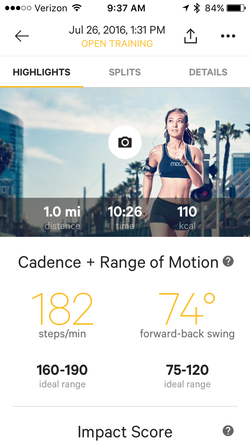 The summary screen on completing a run, showing Cadence and range of motion. | |
